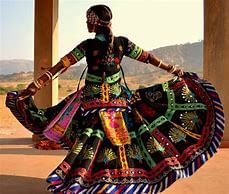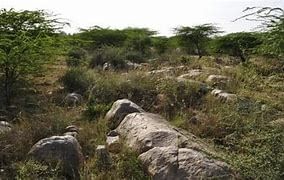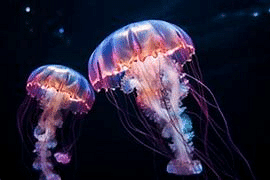UPSC Daily Current Affairs- 1st December 2023 | Current Affairs & Hindu Analysis: Daily, Weekly & Monthly PDF Download
GS-I
Kalbeliya Dance
Subject: Art and Culture

Why in News?
Recently, during the Rajasthan International Folk Festival, artists performed the Kalbeliya dance.
About Kalbeliya Dance:
- It is a folk dance from Rajasthan.
- It is well known by other names like 'Sapera Dance' or 'Snake Charmer Dance'.
- It is particularly performed by a Rajasthani tribe called 'Kalbelia'.
- This dance has become so well-known throughout the world that this dance and its songs have been included in UNESCO's representative list of the Intangible Cultural Heritage of Humanity since 2010.
- In Kalbelia dance, males play various traditional instruments and females perform the dance.
- It is one of the most sensuous dances among all Rajasthani dances.
- In this dance form, the main performers are female dancers who dance and swirl, replicating the movements of a serpent.
- The dancers wear brightly coloured skirts, blouses, and heavy jewellery.
- Instruments: The male musicians typically play the dhol (a drum), the pungi (a snake charmer’s pipe), and the khanjari (a tambourine).
Source: India Times
GS-II
US Allegations on India in Terrorist Execution Plot
Subject: International Relations

Why in News?
US Allegations: The US has implicated an Indian official in a plot to assassinate a Khalistani terrorist, raising serious concerns for the Ministry of External Affairs (MEA).
- Indian Government’s Stance: While the MEA acknowledges the gravity of the situation, it refutes the claims of the Indian diplomat’s involvement.
Backdrop and Timing of the Allegations
- Concurrent Events: The indictment period coincided with PM Narendra Modi’s visit to the G7 and Quad leaders’ summit and the India-US Defence Industrial Cooperation Roadmap’s conclusion.
- Profile of the Accused Official: Described as a “Senior Field Officer” with a background in security management, intelligence, and military training, the official is also noted to have served in the Central Reserve Police Force.
Pre-Indictment Measures by India
- Proactive Steps: Anticipating the indictment, India formed a high-level inquiry committee on November 18.
- Committee Composition: Likely includes officials from intelligence, investigative, law enforcement agencies, and the MEA.
- Prior Diplomatic Engagements: The indictment followed months of diplomatic and intelligence discussions between the US and India, including meetings between US NSA Jake Sullivan and NSA Ajit Doval, and CIA Director William Burns’ visit to India.
India’s Diplomatic Response
- Contrast with Canada’s Allegations: India’s response contrasts with its reaction to Canada’s allegations regarding the killing of another Khalistani separatist, Hardeep Singh Nijjar, where it accused Canada of being a “safe haven” for extremists.
- Previous Incident with the US: Recalls the 2013 incident involving Devyani Khobragade (IFS), which led to diplomatic tensions but was later resolved.
- Current Approach: India is showing restraint, prioritizing its relationship with the US, and aiming to prevent the situation from escalating into a diplomatic crisis.
US-India Relations: A Complex Dynamic
- Strategic and Values-Based Partnership: The relationship has evolved over decades, marked by significant trade and strategic interests, and a debate over shared values versus strategic interests.
- Historical Perspective: The relationship has weathered various challenges, including the Nixon-Kissinger era, nuclear tests sanctions, and the Indo-US nuclear deal.
Way Forward
- Commitment to Investigation: India’s thorough investigation is crucial for maintaining its credibility and managing its relationship with the US.
- Extradition Considerations: India must question why the US is not keen on extraditing a man facing terror charges to India.
- Global Diplomatic Impact: The outcome will affect India’s relations with the “Five Eyes” intelligence partner countries.
- India’s reputation: India’s reputation as a consistent and credible power is at stake, necessitating a wise and principled approach.
Conclusion: Navigating a Diplomatic Tightrope
- The Indian government faces a delicate diplomatic challenge in addressing the US allegations.
- Balancing national integrity with maintaining robust international relations, especially with a key partner like the United States, is crucial for India’s diplomatic posture and global standing.
Source: Deccan Herald
Narendra Modi writes: India’s G20 presidency, for the world
Subject: International Relations
Why in News?
India’s G20 presidency prioritized inclusivity, sustainable development, and climate action, offering an alternative to GDP-centric progress. The emphasis on the Global South’s concerns and achievements in digital infrastructure collaboration marked a departure from the status quo.
Key Highlights:
- India’s G20 presidency focused on inclusive, ambitious, action-oriented, and decisive strategies.
- Inclusivity was a central theme, integrating the African Union and emphasizing the Global South’s concerns.
- India introduced the Digital Public Infrastructure (DPI) and a Green Development Pact for sustainable progress.
- The G20 2023 Action Plan targeted SDGs, with a special emphasis on health, education, gender equality, and environmental sustainability.
- Commitment to climate justice, equity, and significant financial support for developing countries were key features.
Key Challenges:
- Addressing conflicts, competition, and declining multilateralism.
- Balancing development cooperation amid geopolitical tensions.
- Navigating the transition from GDP-centric to human-centric progress.
- Mobilizing substantial resources for climate and development financing.
Key Terms:
- Vasudhaiva Kutumbakam
- New Delhi Leaders’ Declaration (NDLD)
- Sustainable Development Goals (SDGs)
- Digital Public Infrastructure (DPI)
- Green Development Pact
- Lifestyles for Sustainable Development (LiFE)
- Nationally Determined Contributions (NDCs)
- Multilateral Development Banks
Key Phrases:
- “One Earth, One Family, One Future”
- “Voice of the Global South Summit”
- “People’s Presidency”
- “Jan Bhagidari” (People’s participation)
- “Digital Public Infrastructure Repository”
- “Tripling of global renewable energy capacity by 2030”
- “Climate justice and equity”
- “Women’s Reservation Bill 2023”
Key Statements:
- “Inclusivity has been at the heart of our presidency.”
- “India sought to offer the world an alternative to the status quo, a shift from a GDP-centric to human-centric progress.”
- “India’s Women’s Reservation Bill 2023 epitomizes our commitment to women-led development.”
- “India’s G20 achieved 87 outcomes and 118 adopted documents, a marked rise from the past.”
Key Examples and References:
- The inclusion of the African Union in the G20.
- ‘Voice of the Global South Summit.’
- Digital innovations like Aadhaar, UPI, and Digilocker.
- G20’s emphasis on climate-conscious consumption and planet-friendly production.
- India’s leading role in UN reforms.
Key Facts:
- G20 achieved 87 outcomes and 118 adopted documents during India’s presidency.
- The G20 Declaration calls for tripling global renewable energy capacity by 2030.
- India’s Women’s Reservation Bill 2023 reserves one-third of parliamentary and state legislative assembly seats for women.
- Developing countries require $5.9 trillion to fulfill their NDCs by 2030.
Key Data:
- The G20 reached 1.4 billion citizens through “Jan Bhagidari” events.
Critical Analysis:
India’s G20 presidency successfully navigated challenges, emphasizing inclusivity, sustainable development, and climate action. The presidency revitalized multilateralism and amplified the voice of the Global South, marking a significant shift in the global narrative.
Way Forward:
- Sustaining the momentum of inclusivity and global collaboration.
- Implementing the G20 2023 Action Plan for accelerated progress on SDGs.
- Continued advocacy for climate justice, equity, and financial support for developing nations.
- Strengthening the role of Multilateral Development Banks for effective development financing.
- Advancing UN reforms for a more equitable global order.
Source: The Hindu
GS-III
Asola Bhatti Wildlife Sanctuary
Subject: Environment and Ecology

Why in News?
The Delhi High Court recently indicated it may stay an event proposed by the forest department inside the Asola Bhatti Wildlife Sanctuary.
About the Asola Bhatti Wildlife Sanctuary:
- Location:
- The sanctuary covers an area of 32.71 sq. km on the Southern Delhi Ridge of the Aravalli hill range on the Delhi-Haryana border.
- It lies in Southern Delhiand the northern parts of Faridabad and Gurugram districts of Haryana state.
- It is also part of the Sariska-Delhi Wildlife Corridor, which runs from the Sariska Tiger Reserve in Rajasthan to Delhi Ridge.
- Vegetation:
- As per Champion & Seth (1968), the vegetation falls under the Northern Tropical Thorn Forests type.
- The native plants exhibit xerophytic adaptations such as thorny appendages, wax-coated, succulent, and tomentose leaves.
- Climate: It is mainly influenced by its remote inland position and prevalence of air of continental character, which is characterized by extreme summer heat alternating with great winter cold.
- Flora: Consists of Prosopis juliflora as the dominant exotic species and Diospyros montana as the dominant native species in the sanctuary.
- Fauna: Golden Jackals, Striped-Hyenas, Indian crested-Porcupines, Civets, Jungle Cats, Snakes, Monitor Lizards, Mongoose etc.
Source: Times of India
Exercise MILAN
Subject: Defence & Security

Why in News?
Scheduled for February 2024, Exercise MILAN is set to be India’s largest multilateral naval exercise, with over 50 countries expected to participate.
Exercise MILAN
- Origin: Biennial exercise initiated by the Indian Navy in 1995 at the Andaman and Nicobar Command.
- Initial Participation: Began with four countries – Indonesia, Singapore, Sri Lanka, and Thailand in 1995.
- Growth over Years: The exercise has significantly grown in the number of participants and the complexity of exercises.
- Expansion with Policies: Expanded under India’s ‘Act East policy’ and the SAGAR initiative.
- Broader Inclusion: Now includes island nations in the Western Indian Ocean Region (IOR) and IOR littoral states.
Significance of Exercise MILAN
- Showcasing Naval Strength: This exercise reflects the Indian Navy’s growing engagement and capability to assist as a first responder and Preferred Security Partner in the Indian Ocean Region (IOR).
- Enhanced Operational Reach: The Indian Navy’s increasing presence and operational reach through Mission Based Deployments and other engagements underscore India’s commitment to strong defense ties.
- Importance of Naval Exercises: Conducting 17 multilateral and 20 bilateral exercises annually, these events are crucial for operational capability enhancement, interoperability, and strengthening diplomatic and maritime security ties.
Source: Indian Express
Santjordia Pagesi
Subject: Environment and Ecology

Why in News?
Scientists have now confirmed the existence of a new species named Santjordia pagesi.
About Santjordia Pagesi:
- Santjordia pagesi, also called St. George’s Cross medusa jellyfish, is a newly discovered species of jellyfish.
- It is considered “rare” and has been found only in the Sumisu Caldera near the Ogasawara Islands, about 600 miles southeast of Tokyo, Japan.
- “Santjordia” refers to Saint George in Catalan, representing its cross-shaped stomach.
- Features:
- It is considered large at 4 inches wide and 3 inches tall.
- It boasts a circular body with around 240 tentacles.
- Its body looks almost like a see-through cushion. It has a thick white ring running along its lower edge.
- Smaller vein-like structures stretch from its prominent central stomach to the outer ring.
- Its most distinctive feature is a bright red, cross-shaped stomach.
- The jellyfish’s distinct features suggest it may possess a novel cnidarian venom.
What is a Jellyfish?
- A jellyfish is a type of marine animal belonging to the phylum Cnidaria, which includes creatures such as sea anemones, sea whips, and corals.
- Like all members of the phylum, the body parts of a jellyfish radiate from a central axis.
- These are found in oceans around the world and come in various shapes and sizes.
- Jellyfish have a soft, transparent, and umbrella-shaped bell that can pulsate for movement. Hanging from the bell are tentacles.
- Jellyfish have tiny stinging cells in their tentacles to stun or paralyse their prey before they eat them.
- Inside their bell-shaped body is an opening that is their mouth. They eat and discard waste from this opening.
Source: AIR
India plans to develop its own ‘Sovereign AI’
Subject: Science and Technology
Why in News?
In a strategic move towards bolstering its technological prowess, India is set to extend its Digital Public Infrastructure (DPI) model to artificial intelligence (AI), aiming for sovereign AI capabilities.
Sovereign AI Initiative
- Strategic Direction: Minister of State for Electronics and IT has articulated India’s commitment to developing its own sovereign AI, diverging from solely relying on ecosystems driven by global tech giants.
- Focus Areas: The government’s AI strategy is based on practical applications in sectors like healthcare, agriculture, and governance, aiming for broader economic impact.
Tech Governance Solutions so far
- Global Positioning: India is showcasing itself as a leader in using technology for large-scale governance solutions.
- Prominent Examples: The country highlights its Aadhaar bio-metric identity program and the Unified Payments Interface (UPI) as key achievements.
- Digital Public Infrastructure (DPI): This concept involves government-backed technology frameworks that are later expanded upon by private entities for various applications.
India’s Strategy for AI Control
- Policy Framework: The National Data Governance Framework Policy, proposed by MeitY, aims to create an India Datasets platform, aggregating non-personal and anonymized government data.
- Empowering Innovation: This initiative is designed to provide startups and researchers with access to valuable data for AI development and research.
- Objective: The policy’s goal is to modernize data collection to enhance governance and stimulate an AI-centric startup ecosystem.
Unified National Data Sharing Platform
- Report Findings: A recent IT Ministry report highlighted the India datasets program as a key to enabling diverse data sharing and exchange use cases.
- Data Monetization: The potential monetization of non-personal data is seen as a catalyst for innovation and growth in the AI sector.
Regulating AI in India
- Legislative Outlook: India’s future AI governance laws are expected to reflect the significant role AI plays in the digital economy.
- Regulatory Approach: The government plans a hybrid regulatory model, incorporating elements of both European and American frameworks.
- Tech Giants’ Data Sharing: A proposed directive, part of the draft Digital India Bill, may require major tech companies to contribute non-personal data to a government database.
- Legislative Timeline: The Digital India Bill is anticipated to be a focus for the government post the 2024 general elections.
- Committee Recommendations: A MeitY-appointed committee suggested utilizing aggregated non-personal data for economic gains, identifying specific high-value datasets for this purpose.
Conclusion
- In its pursuit of sovereign AI and robust digital public infrastructure, India is positioning itself as a key player in the global AI domain.
- The focus on practical AI applications, combined with a balanced regulatory approach, aims to foster innovation, ensure effective data governance, and drive economic growth.
Source: Indian Express
|
44 videos|5271 docs|1113 tests
|
FAQs on UPSC Daily Current Affairs- 1st December 2023 - Current Affairs & Hindu Analysis: Daily, Weekly & Monthly
| 1. What is the significance of the Kalbeliya Dance in Indian culture? |  |
| 2. What are the allegations made by the US on India regarding a terrorist execution plot? |  |
| 3. What is the significance of Narendra Modi's article on India's G20 presidency? |  |
| 4. What is the Asola Bhatti Wildlife Sanctuary known for? |  |
| 5. What is Exercise MILAN and its significance? |  |





















